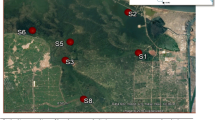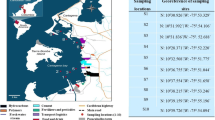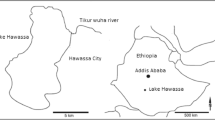Abstract
Concentrations and distribution of chlorinated hydrocarbon insecticides, polychlorinated biphenyls (PCB's) and some metals were determined in two South African lakes, Hartbeespoort Dam and Voëlvlei Dam. Water, bottom sediments, aquatic plants, aquatic insects, fish, fish-eating birds and their eggs were collected.
Insecticides and PCB's were analyzed by thin layer and gas chromatography and mass-spectrometry. Analysis of metals was accomplished with atomic absorption spectrophotometry. Metals included arsenic, cadmium, copper, manganese, lead, zinc, and mercury.
The insecticide residues most commonly found in both dams were DDE, DDD, DDT, and dieldrin. Hartbeespoort had higher levels than Voëlvlei of insecticides and PCB's in all types of samples common to both lakes. Concentrations of PCB's having six or more chlorines increased with an increase in the trophic level. Concentrations of PCB's in the brains of the African birds were greater than the average total concentration of insecticides while the opposite was true for carcasses. Biological magnification of insecticides and PCB's occurred in both lakes.
Hartbeespoort Dam had higher levels than Voëlvlei for all metals examined in bottom sediments and birds, except for copper in bird carcasses. Mercury levels in bird carcasses ranged from 2- to 5-fold greater than in fish while lead concentrations ranged from 2- to 10-fold greater.
Similar content being viewed by others
References
Adler, E.: Hartbeespoort Dam—asset or disaster? Veldtrust Ang., Natl. Veld Trust, Johannesburg, R.S.A. (1974).
Albro, P. W., and L. Fishbein: Intestinal absorption of polychlorinated biphenyls in rats. Bull. Environ. Contamin. Toxicol.8 26 (1972).
Bensen, W. W., D. W. Brock, J. Gabica, and M. Loomis: Pesticide and mercury levels in pelicans in Idaho. Bull. Environ. Contamin. Toxicol.15 543 (1976).
Bowes, G. W., and C. J. Jonkel: Presence and distribution of polychlorinated biphenyls (PCB) in Arctic and Subarctic marine food chains. J. Fisheries Research Board Canada32 2111 (1975).
Buhler, D. R.: Environmental contamination by toxic metals. Dept. of Agricultural Chemistry, Oregon State U., 1 (1972).
Deelstra, H., J. L. Power, and C. T. Kenner: Chlorinated hydrocarbon residues in the fish of Lake Tanganyika. Bull. Environ. Contamin. Toxicol.15 689 (1976).
Fimreite, N., W. N. Holsworth, J. A. Keith, P. A. Pearce, and I. M. Gruchy: Mercury in fish and fish-eating birds near sites of industrial contamination in Canada. Canadian Field Naturalist85 211 (1971).
French, M. C., and D. J. Jefferies: The preservation of biological tissue for organochlorine insecticide analysis. Bull. Environ. Contamin. Toxicol.6 460 (1971).
Funk, W. H., R. W. Rabe, R. Filby, and J. I. Parker: The biological impact of combined metallic and organic pollution in the Coeur D'Alene-Spokane River drainage system. National Technical Information Service #PB-222 946 (1973).
Grant, D. L., W. E. J. Phillips, and D. C. Villeneuve: Metabolism of a polychlorinated biphenyl (Aroclor 1254) mixture in the rat. Bull. Environ. Contamin. Toxicol.6 102 (1971).
Greichus, Y., D. Lamb, and C. Garrett: Efficiency of extraction of metabolically incorporated HEOD (carbon-14) from pheasant tissues, eggs and faeces. Analyst93 323 (1968).
Greichus, Y. A., A. Greichus, and R. J. Emerick: Insecticides, polychlorinated biphenyls and mercury in wild cormorants, pelicans, their eggs, food and environment. Bull. Environ. Contamin. Toxicol.9 321 (1973).
Greichus, Y. A., J. J. Worman, M. A. Pearson, and D. J. Call: Analysis of polychlorinated biphenyls in bird tissues and Aroclor standards with gas chromatography and mass spectrometry. Bull. Environ. Contamin. Toxicol.11 113 (1974).
Harvey, G. R., W. G. Steinhauer, and J. M. Teal: Polychlorobiphenyls in north Atlantic ocean water. Science180 643 (1973).
Hickey, J. J., J. A. Keith, and F. B. Coon: An exploration of pesticides in a Lake Michigan ecosystem. J. Appl. Ecol.3 141 (1966).
Hunt, E. G., and A. I. Bischoff: Inimical effects on wildlife of periodic DDD applications to Clear Lake. CA Fish and Game46 91 (1960).
Jensen, S., A. G. Johnels, M. Olson, and G. Otterlund: DDT and PCB in marine animals from Swedish waters. Nature224 247 (1969).
Koeman, J. H., M. C. Ten Noever de Brauw and R. H. de Vos: Chlorinated biphenyls in fish, mussels and birds from the river Rhine and the Netherlands coastal area. Nature221 1126 (1969).
Koeman, J. H., J. H. Pennings, J. J. M. De Goeij, P. S. Tjioe, P. M. Olindo, and J. Hopcraft: A preliminary survey of the possible contamination of Lake Nakuru in Kenya with some metals and chlorinated hydrocarbon pesticides. J. Appl. Ecology9 411 (1972).
Krantz, W. C., B. M. Mulhern, G. E. Bagley, A. Sprunt, IV, F. J. Ligas, and W. B. Robertson, Jr.: Organochlorine and heavy metal residues in bald eagle eggs. Pesticide Monitoring J.4 136 (1970).
Leland, H. V., and N. F. Shimp: Distribution of selected trace metals in southern Lake Michigan and lower Green Bay. Water Resources Research Center, Report No.84 (1974).
Mathis, B. J., and N. R. Kevern: Distribution of mercury, cadmium, lead and thallium in an eutrophic lake. National Technical Information Service #PB-221 993 (1973).
Mulhern, B. M., E. Cromartie, W. L. Reichel, and A. A. Belisle: Semiquantitative determination of polychlorinated biphenyls in tissue samples by thin layer chromatography. J. Ass. Offic. Anal. Chem.54 548 (1971).
Nisbet, I. C. T., and A. F. Sarofim: Rates and routes of transport of PCB's in the environment. Environ. Health Persp.1 21 (1972).
“Official Methods of Analysis”, Manual,Association of Official Agricultural Chemists, Washington, D.C. (1965).
Perhac, R. M.: Heavy metal distribution in bottom sediment and water in the Tennessee River-Loudon Lake reservoir system. Water Resources Research Center, Report No.40 (1974).
Pesticide Analytical Manual,U.S. Dept. of Health, Education and Welfare, Food and Drug Administration (Vol I and II with additions), (1968).
Prestt, I., D. J. Jefferies, and N. W. Moore: Polychlorinated biphenyls in wild birds in Britain and their avian toxicity. Environ. Pollut.1, 3 (1970).
Risebrough, R. W., D. B. Peakall, S. G. Herman, and M. N. Kirven: Polychlorinated biphenyls in the global ecosystem. Nature220 1098 (1968).
Stemp, A. R., B. J. Liska, B. D. Langlois, and W. J. Stadelman: Analysis of egg yolk and poultry tissues for chlorinated insecticide residues. Poultry Sci.43, 273 (1964).
Tatton, J. O'G., and J. H. A. Ruzicka: Organochlorine pesticides in Antarctica. Nature215 346 (1967).
Van der Westhuizen, O. S.: Engineer,Dept. of Water Affairs, Capetown, Republic of South Africa “unpublished report” (1972).
Author information
Authors and Affiliations
Rights and permissions
About this article
Cite this article
Greichus, Y.A., Greichus, A., Amman, B.D. et al. Insecticides, polychlorinated biphenyls and metals in African lake ecosystems. I. Hartbeespoort Dam, Transvaal and Voëlvlei Dam, Cape Province, Republic of South Africa. Arch. Environ. Contam. Toxicol. 6, 371–383 (1977). https://doi.org/10.1007/BF02097778
Received:
Accepted:
Issue Date:
DOI: https://doi.org/10.1007/BF02097778




